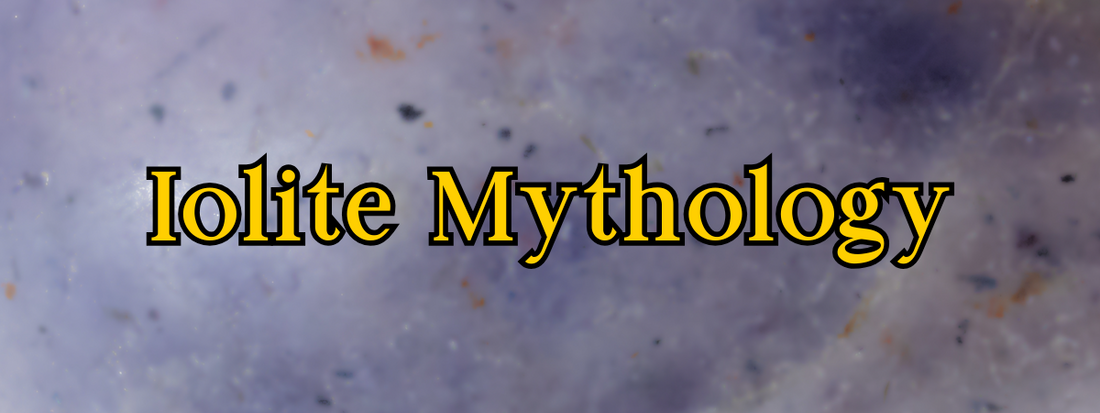
Iolite Myths and Legends: A Gem of Vision, Navigation, and Spiritual Insight
Iolite, with its mesmerising shades of blue and violet, has long been a gemstone shrouded in mystery and wonder. Though lesser-known than tanzanite or sapphire, iolite has a rich history woven into the myths, legends, and traditions of ancient cultures. From Viking explorers to spiritual seekers, this gemstone has been revered for its connection to vision, guidance, and inner wisdom for centuries.
 Iolite and the Viking Navigators
Iolite and the Viking Navigators

Perhaps the most well-known association with iolite comes from The Vikings and their legendary sunstone.
Viking sailors, famed for their conquests and explorations, faced the challenge of navigating through the often-cloudy and fog-laden North Atlantic. According to legend, they discovered that iolite functioned as a "sunstone", a natural polarising filter that allowed them to locate the sun’s position even on overcast days.
By looking through an iolite lens and rotating it, they could determine the direction of sunlight, helping them chart their course with remarkable accuracy. This use of iolite is more than just folklore; scientific studies have confirmed that certain crystals, including iolite, can indeed function as natural polarising filters. Whether or not Viking navigators truly relied on iolite, its reputation as the sunstone has lead to its nickname 'The Viking Compass'
Interested in the the Viking Sunstone? Click Here to read more about it.
 Iolite in Ancient Egypt: The Eye of Horus
Iolite in Ancient Egypt: The Eye of Horus

In Egyptian mythology, Horus, the falcon-headed god of the sky, war, and protection, lost one of his eyes in a fierce battle against his uncle Set, the god of chaos.
Some interpretations suggest that a deep blue or violet gemstone was used as a substitute eye to restore his sight and symbolise his regained power. While there is no definitive evidence that iolite was the gemstone in question, its colouring makes it an interesting possibility.
The symbol of the Eye of Horus became a powerful amulet in ancient Egypt, worn to ensure safety, strength, and wisdom. If iolite was indeed among the gemstones used in these talismans, it would have been highly prized for its association with both physical and spiritual sight.
Want to discover the full story? Click Here
 Iolite in Ancient India: A Stone of the Third Eye
Iolite in Ancient India: A Stone of the Third Eye
Although ancient Hindu texts do not specifically mention iolite, its deep blue hues and optical properties align with the qualities associated with the third-eye chakra in modern interpretations. The gemstone is thought to aid in meditation, helping spiritual seekers detach from the illusions of the material world and focus on their inner journey.
It was sometimes used in rituals to invoke wisdom, clarity, and a deeper connection to divine consciousness.
 Iolite in Greek and Roman Mythology
Iolite in Greek and Roman Mythology
While iolite does not feature prominently in surviving Greek or Roman myths, its colour and optical properties suggest that it may have been associated with gods of vision and foresight.
Some scholars speculate that it was linked to Apollo, the god of prophecy and truth, or Hermes, the messenger god who guided souls between the mortal and divine realms. The stone’s shifting hues, appearing deep blue from one angle and lighter blue or even colourless from another, may have inspired ancient beliefs that it could reveal hidden truths or aid in deciphering the will of the gods.
 Iolite in Early Medieval Europe
Iolite in Early Medieval Europe
By the early medieval period, deep blue and violet gemstones were often linked to nobility and divine favour. Though amethyst was the dominant stone for spiritual wisdom, iolite may have been used as a talisman by those seeking inner strength and clarity.
Some early European texts reference "water sapphires," a term believed to have been used for iolite. These stones were sometimes worn by travellers or sailors who believed they could offer guidance and protection on long journeys.
 Iolite in Shamanic Traditions
Iolite in Shamanic Traditions
Iolite has also been linked to shamanic practices, particularly in regions where blue and violet stones were prized for their mystical qualities.
Shamans and healers may have used iolite to enhance visions, induce lucid dreams, or communicate with spiritual guides. In some traditions, it was considered a "portal stone", a gemstone that could help open the mind to other realms and dimensions.
 A Gemstone of Transformation and Vision
A Gemstone of Transformation and Vision
While iolite may not have the same widespread historical prominence as rubies or emeralds, its unique optical properties and rich legends make it a truly fascinating gemstone.
Whether guiding Viking sailors across the open sea, aiding spiritual seekers in meditation, or inspiring myths of divine foresight, iolite has long been associated with vision, clarity, and transformation. Even today, iolite continues to captivate those who seek a gemstone with both beauty and meaning.
Whether you admire it for its historical significance or its mystical allure, iolite remains a stone of exploration, both in the world around us and within ourselves.

Want to read more about iolite gemstones? Here are my other iolite themed topics:
A jewellers guide to iolite (gem profile)
